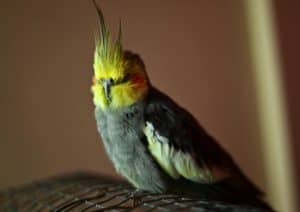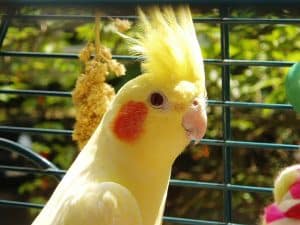Thinking about adding a feathered friend to your family? Cockatiels, with their distinctive crests and charming personalities, are among the most popular pet birds. They’re known for their sociability and relatively easy care, making them ideal companions, especially for first-time bird owners. As you embark on this exciting journey, understanding cockatiel basics is essential to ensure a happy and healthy life for your new pet bird.
From setting up the perfect cockatiel habitat to mastering the essentials of daily care, getting to know the needs of your cockatiel can seem daunting at first. But don’t worry! With the right information and a bit of preparation, you’ll be well-equipped to provide a loving home. Let’s dive into what you need to know about cockatiel basics, setting the stage for a rewarding relationship with your new feathered friend.
Cockatiel Overview

Cockatiels have risen in popularity as pets due to their friendly nature and manageability, especially suitable for those new to bird keeping. This section delves into the specifics of “cockatiel basics,” focusing on essential aspects that help in creating an enriching environment for these charming birds.
What Is a Cockatiel?
A cockatiel is a small, crested member of the cockatoo family native to Australia. Known for their distinctive crest feathers and round cheeks, cockatiels possess a playful and affectionate temperament which makes them excellent pets. They are capable of mimicking speech although their ability isn’t as pronounced as some larger parrots.
Typically, cockatiels display a variety of color patterns, originally grey with visible differences between males and females. Males generally exhibit brighter colors and more pronounced facial markings than females.
Native Region and Natural Habitat
Cockatiels are indigenous to the diverse landscapes of Australia, thriving mainly in areas that offer open country adorned with bodies of water like creeks and lakes. In the wild, these birds are adaptive, often found in arid or semi-arid regions but always close to water sources. Their natural habitat consists of bushlands and wetlands, where they have access to grass seeds, which form a large part of the cockatiel’s diet.
When setting up a cockatiel’s cage, mimicking their natural habitat provides not only comfort but also essential mental stimulation. Ensure the cage is spacious (minimum cage size recommendations vary, but generally ample space is crucial), and avoid placing it in direct sunlight while ensuring some natural light is present.
When setting up a cockatiel’s cage, mimicking their natural habitat provides not only comfort but also essential mental stimulation. Ensure the cage is spacious (minimum cage size recommendations vary, but generally ample space is crucial), and avoid placing it in direct sunlight while ensuring some natural light is present.
The bar spacing on the cage should be appropriate to prevent escapes or injuries, and multiple perches, along with natural branches, can help simulate their wild environment for better physical and mental health.
Cockatiel Characteristics

Delving into the characteristics of cockatiels reveals much about why these birds are celebrated as companions. Recognizing their distinctive features and behaviors helps you properly care for these engaging pets.
Appearance and Behavior
Cockatiels stand out with their expressive crest feathers, which rise or flatten based on their emotional state. They boast a variety of color patterns, though typically grey bodies with vibrant cheek patches are common. These small birds require cages with specific bar spacing, ideally between 1/2 inch to 5/8 inch, to prevent escape and ensure safety. Daily mental stimulation can be facilitated through interaction, toys, and training.
Proper lighting is also crucial for cockatiels; they should have access to natural light but not be placed in direct sunlight, which can lead to overheating. Additionally, their water dishes need regular cleaning to prevent bacterial growth.
Personality and Social Traits
Cockatiels are notably social birds, thriving on interaction with their owners and other cockatiels. Their friendly and affectionate demeanor makes them excellent pets, especially for those new to bird keeping. Regular socialization prevents negative behaviors such as feather plucking and aggression.
Moreover, these birds require routines that incorporate social interactions, playtime, and training to maintain their mental and emotional health. Providing a varied environment with opportunities for climbing, foraging, and flying within the cage helps meet their need for activity and exploration.
With a balanced approach to physical needs and emotional care, your cockatiel can enjoy a healthy and joyful life as a cherished family member.
Setting up Your Cockatiel’s Habitat
Creating an ideal environment for your cockatiel is pivotal to its health and happiness. This section will guide you on how to establish a habitat that mirrors the natural Australian setting they thrive in, ensuring they remain active and entertained.
Choosing the Right Enclosure
Selecting the suitable enclosure for your cockatiel involves several key considerations. The cage size is crucial; ideally, the minimum cage size should be 20 inches long, 20 inches wide, and 24 inches high. However, if your space allows, a larger cage is always better to provide ample space for flying and exercise.
Ensure the cage has horizontal bars to facilitate climbing, and bar spacing should not exceed 5/8 inches to prevent your bird from attempting to escape or getting stuck. Opt for cages with removable trays to facilitate easy cleaning. Placing the cage in a location free of direct sunlight will protect your cockatiel from overheating yet ensure it still benefits from a natural light cycle.
Essential Supplies and Accessories
Your cockatiel’s cage requires more than just good construction; it needs the right accessories. Start with multiple perches of varying materials and thicknesses to improve foot health and encourage natural behaviors. Natural branches work best for replicating their wild environment and providing mental stimulation.
High-quality, specially formulated pellet food should be provided alongside fresh vegetables and occasional treats to ensure balanced nutrition. Water dishes must be accessible and cleaned daily to maintain hygiene. Don’t forget enrichment toys, such as swings and ladders, which play a crucial role in keeping your cockatiel engaged and mentally stimulated.
Bedding and Lighting Requirements
Bedding in a cockatiel’s cage absorbs waste and can affect their health. Paper-based products or aspen shavings are preferred because they are safe and easy to replace. Avoid using cedar or pine shavings as they can be toxic to birds. Regularly change the bedding to prevent the build-up of waste and bacteria.
For lighting, while direct natural light is to be avoided, ensure your pet cockatiel’s habitat is well-lit with indirect sunlight. If natural light isn’t sufficient, especially during winter months, consider using an artificial UV light to provide the necessary spectrum for your cockatiel’s health. This mimics their natural habitat and helps maintain their natural circadian rhythm.
Daily Cockatiel Care and Maintenance

Daily care and maintenance are crucial for keeping your cockatiel healthy and happy. This section provides essential information on feeding, cleaning, and grooming your pet cockatiel.
Feeding: Diet and Nutrition
A balanced diet is vital for your cockatiel’s health. Feed your bird a mixture of specially formulated pellet food, which provides all the essential nutrients they need. Alongside pellets, offer fresh vegetables and occasional fruits to ensure they receive a variety of vitamins. Fresh foods like leafy greens, carrots, and apples are excellent choices. Always make sure that water dishes are clean and filled with fresh water every day. By providing a varied diet, you’ll help maintain your cockatiel’s robust health and vitality.
Routine Cleaning Practices
Keeping your cockatiel’s cage clean is essential for preventing diseases and maintaining a comfortable environment. Daily, remove any food waste and wipe down surfaces with a clean spray bottle. Weekly, wash all bedding or substrates and clean the cage thoroughly to eliminate potential germs.
Ensure that the bar spacing on the cage is appropriate to prevent your cockatiel from escaping or getting stuck. Pay close attention to the cleanliness of water dishes and food bowls, as these can harbor bacteria that may lead to health issues.
Grooming Needs
Regular grooming is necessary for your cockatiel’s well-being. This includes trimming their nails every few weeks and checking their distinctive crest and overall feathers for dirt or parasites. Offer a shallow bowl of water or a clean spray bottle for them to bathe, which helps in maintaining their feather health.
Occasionally, ensure they get enough sunlight but avoid direct sunlight which can be harmful. Grooming provides not only cleanliness but also mental stimulation, helping to keep your feathered friend active and engaged.
- CAGE LINERS FOR PET BIRDS: Place these liners underneath the grate of your parrot or parakeet cage for an easy way to keep your pets home clean
- ULTRA ABSORBENT: The soft, quilted top and sturdy inner layer absorb moisture, and the leak-proof bottom ensures your pets cage stays dry and comfortable
- REDUCES ODOR: Keeps your home, and your pet birds home, smelling fresh and clean
- EASY CLEAN UP: Cleaning is a breeze: just fold up these bird cage liners and throw them away
- HOLDS ITS SHAPE: Won't get soggy and gross like newspaper
Health and Veterinary Care
When caring for your cockatiel, understanding their health and wellness needs is imperative. Optimal care ensures your feathered friend leads a full, healthy life.
Recognizing Signs of Good Health
A healthy cockatiel displays vibrant energy levels, bright eyes, and a clean, full plumage that includes their distinctive crest. You’ll notice their active engagement with toys and their environment, a sign of good mental stimulation. Consistent vocalizations and a steady appetite for their specially formulated diet also indicate wellbeing. Regular observation ensures you catch these positive signs, helping you gauge your bird’s health effectively.
Common Health Issues
Even with excellent care, cockatiels can develop health issues, of which respiratory problems, feather plucking, and gastrointestinal disturbances are the most common. Poor ventilation can lead to respiratory distress, while inadequate nutrition or mental stimulation often results in feather plucking. Observing your cockatiel for any changes in behavior, such as decreased activity or lack of appetite, is crucial. Additionally, ensure cleanliness in their water dishes and cage to prevent bacterial infections which can exacerbate health problems.
When to Consult a Vet
If you observe any noticeable changes in your cockatiel’s health or behavior, it’s important to consult an avian veterinarian. Warning signs of a sick bird include a puffed-up appearance, alterations in fecal output, unusual inactivity, or physical distress such as limping or difficulty breathing. Early intervention by a vet is crucial, especially for serious conditions like egg binding or severe infections. Scheduling annual check-ups with a veterinarian can help prevent many potential health issues and ensure your cockatiel stays in good condition.
Understanding Your Cockatiel’s Needs: From Wild to Pet
Cockatiels are fascinating birds, whether in the wild or as beloved pets. Understanding their natural behaviors and needs can greatly enhance their well-being and help you recognize when something might be wrong. Let’s explore the distinctions between wild and pet cockatiels and how to address the needs of both male and female cockatiels.
Wild vs. Pet Cockatiels
In their natural habitat, wild cockatiels exhibit behaviors that are crucial for their survival and well-being. They live in flocks, forage for seeds and fruits, and navigate a range of environmental challenges. Their social structure, diet, and activity levels are tailored to the demands of the wild. Observing these behaviors helps pet owners recreate an enriching environment for their cockatiels, ensuring they receive the mental and physical stimulation they need.
Pet cockatiels, on the other hand, rely on their owners to provide for their needs. While pet cockatiels may not face the same survival challenges as their wild counterparts, they still require a stimulating environment, social interaction, and a balanced diet to thrive. Creating a habitat that mimics their natural environment can prevent boredom and behavioral issues.
Male vs. Female Cockatiels: Key Differences
Both male and female cockatiels make wonderful pets, but they exhibit some distinct behaviors and characteristics. Male cockatiels are often more vocal and may develop a stronger bond with their owners. They are known for their whistling and ability to mimic sounds, which can be a delightful aspect of their companionship.
Male vs. Female Cockatiels: Key Differences
Both male and female cockatiels make wonderful pets, but they exhibit some distinct behaviors and characteristics. Male cockatiels are often more vocal and may develop a stronger bond with their owners. They are known for their whistling and ability to mimic sounds, which can be a delightful aspect of their companionship.
Female cockatiels, while less vocal, are equally affectionate and can display their own unique behaviors. They may be more independent and have a different way of interacting with their owners. Understanding these differences can help you tailor your care to meet the specific needs of your male or female cockatiel.
Wrapping Up: What are the Cockatiel Basics?
Embracing the journey of cockatiel ownership enriches your life with joy and companionship. Equipped with the right knowledge about their care habitat and health needs you’re well-prepared to provide a nurturing environment for your feathered friend. Remember regular engagement and preventive veterinary care are key to a long healthy life for your cockatiel. Enjoy every moment with your playful new companion as you both embark on this exciting adventure together.
Other suggested articles:





Very interesting topic, thanks for posting.Raise
your business